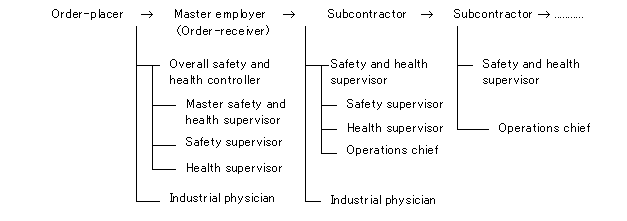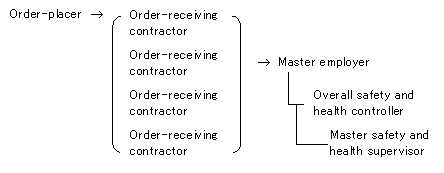JICOSH Home >
OSH Japan >
Outline of Japan's Industrial Safety and Health Law
 |
| 14. Safety Management System in Construction Work |
||
| Even after the enactment of the Industrial
Safety and Health Law in 1972, regulations
to prevent industrial accidents in
construction
work have been strengthened in several
steps,
as serious accidents have continued
to occur
and have resulted in a large number
of casualties
|
||
| At the same time, it is a common practice
in Japan's construction industry for
a master
employer, having contract with the
order-placer
to carry out an entire project, employs
several
subcontractors to undertake part of
the contracted
work, and these subcontractors in turn
use
other small subcontractors to share
some
of their work. This practice means
multiple
layers of contractors working together
at
a single workplace. |
||
| Partly due to this situation, a large number
of industrial accidents continue to
occur
in the construction industry. In order
to
resolve this problem, the construction
industry
requires specific arrangements and
systems
for safety and health that are different
from those for other industries. |
||
| 1. Safety and health management systems in
the construction industry |
||
| .The prevention of industrial accidents is
the responsibility of each construction
employer
that employs workers. However, as a
large
number of workers employed by different
employers
are working together at the same workplace,
specific systems or programs for accident
prevention are required in the construction
industry to ensure the safety of all
workers,
including subcontractor workers, in
addition
to the responsibility of each employer. |
||
| (1)Management system at a workplace where
a master employer employs two or more subcontractors: |
||
 |
||
| (a) | Types of undertakings and the number of workers
for which an overall safety and health controller(Soukatsu-Anzen-Eisei-Sekininsha) must be appointed: |
|
| (i) | Undertakings involving tunnel construction,
bridge construction (limited to construction
on roads or sites close to roads, or
on rails
or sites close to rails, within areas
of
concentrated population) and work using
compressed-air
methods, in which more than 30 workers
are
regularly employed, including subcontractor
workers |
|
| (ii) | Other undertakings in which more than 50
workers are regularly employed, including
subcontractor worker. |
|
| (b) | Employers who must appoint a safety and health supervisor(Anzen-Eisei-Sekininsha) |
|
| All subcontractors must appoint a safety
and health supervisor when they participate
in a construction undertaking for which an
overall safety and health controller(Soukatsu-Anzen-Eisei-Sekininsha) has been appointed. |
||
| (c) | Employers who must appoint a master safety and health supervisor(Motokata-Anzen-Eisei-Kanrisha) |
|
| Master employers must appoint a master safety
and health supervisor for work undertaken
by said employer itself if an overall safety and health controller(Soukatsu-Anzen-Eisei-Sekininsha) has been appointed for the undertaking. |
||
| (d) | Employers who must appoint a safety supervisor,
health supervisor and industrial physician |
|
| Master employers and each subcontractor must
appoint a safety supervisor, health
supervisor
and industrial physician when such
master
employer and subcontractor employ more
than
50 workers at the workplace. |
||
| (e) | Employers who must appoint an operations-chief |
|
| All employers must appoint an operations
chief to any undertaking for which the appointment
of an operations-chief(Sagyo-Shuninsha) is legally required. |
||
| (2)Management system for an undertaking in
which several construction firms are
undertaking work under a joint contract (joint-venture) |
||
 |
||
| (Note) One contractor should be selected
from among joint-venture contractors involved
to serve as the master employer for the undertaking
and to appoint an overall safety and health controller(Soukatsu-Anzen-Eisei-Sekininsha) and a master safety and health supervisor(Motokata-Anzen-Eisei-Kanrisha). The types and scope of the undertaking
for which such controllers and supervisors
must be appointed and the method of appointment
are the same as for Item (1). |
||
| (3)Management system covering work for which
the appointment of an overall safety and health controller(Soukatsu-Anzen-Eisei-Sekininsha) is not required |
||
| (a) | Employers are required to appoint a small-scale
workplace safety and health supervisor
in
the following cases: |
|
| (i) | They are engaged in operations specified
in (1)-(a)-(i), by regularly employing 20
workers or more, including subcontractor
workers; |
|
| (ii) | They are engaged in the construction of structures
whose major elements consist steel
frames
or steel frames and reinforced concrete,
by regularly employing more than 20
workers,
including subcontractor workers; |
|
| (ii) | Works other than (a) or (b) for which by
50 workers or more, including subcontractor
workers, are regularly employed; |
|
| (b) | Appointment of supervisors |
|
| For works described in Item 3)-a above, a
small-scale workplace safety and health supervisor(Tensha-Anzen-Eisei-Sekininsha) must be appointed (except for cases in which
an overall safety and health controller(Soukatsu-Anzen-Eisei-Sekininsha) and a master safety and health supervisor(Motokata-Anzen-Eisei-Kanrisha) are appointed). A small-scale workplace safety and health supervisor(Tensha-Anzen-Eisei-Sekininsha) should belong to the headquarters, branch offices or sales offices responsible for the management and guidance of workplaces. |
||
| (4)Management system for work involving high
risks or hazards |
||
| (a) | Employers are required to appoint a rescue supervisor(Kyugo-Kanrisha) in the following cases: |
|
| (i) | They are engaged in operations at underground
locations with a distance of 1,000
meters
or more from the entrance of a tunnel
under
construction. |
|
| (ii) | They are engaged in the construction of a
shaft with a depth of 50 meters or
more. |
|
| (iii) | They are engaged in work under compressed
air with a gauge pressure of 1kg/cm2
or more. |
|
| (5)Management system for headquarters, etc. |
||
| In the construction industry, headquarters,
branch offices and sales offices not directly
responsible for the management of construction
work are required to have the same management
system as for offices in general (for example,
a safety supervisor must be appointed for
offices employing more than 50 workers). |
||
| 2. Major duties and qualifications of controllers
and supervisors |
||
| (1)Overall safety and health controllers(Soukatsu-Anzen-Eisei-Sekininsha) |
||
| (a) | Duties |
|
| Overall safety and health controllers(Soukatsu-Anzen-Eisei-Sekininsha) shall perform the following duties to prevent
industrial accidents at workplaces where
workers from different employers are working
together: |
||
| (i) | Establishing and administering a consultative
organization |
|
| (ii) | Ensuring better liaison and adjustment among
related operations |
|
| (iii) | Carrying out workplace patrol of the workplace |
|
| (iv) | Providing guidance and assistance in the
safety and health education to be conducted
by related contractors |
|
| (v) | Preparing the schedule relating to the progress
of work and plans relating to the arrangement
of machines, equipment and other facilities
at the workplace and providing guidance
to
related contractors utilizing such
machines
and equipment so as not to violate
any legal
regulations |
|
| (b) | Qualifications |
|
| Persons who carry out the overall control
and management of the relevant undertaking
to which they are appointed as an overall
safety and health controller(for example,
the work site manager) |
||
| (2)Master safety and health supervisors(Motokata-Anzen-Eisei-Kanrisha) |
||
| (a) | Duties |
|
| Master safety and health supervisors(Motokata-Anzen-Eisei-Kanrisha) are responsible for technical matters relevant
to the duties of Overall safety and health controllers(Soukatsu-Anzen-Eisei-Sekininsha). |
||
| (b) | Qualifications |
|
| (i) | Those who are graduates from regular science
courses in universities or technical colleges,
and who have three years or longer (five
years or longer for those who have graduated
courses other than regular scientific course)
of practical experience in the field of safety
and health in the execution of construction
work |
|
| (ii) | Those who are graduates of regular science
courses in senior high schools and
who have
five years or longer (eight years or
longer
for those who are graduates of courses
other
than regular scientific course) of
practical
experience in the field of safety and
health
in the execution of construction work. |
|
| (iii) | Those who have ten years or longer of practical
experience in safety and health at
construction
workplaces. |
|
| (3)Safety and health supervisors(Anzen-Eisei-Sekininsha) |
||
| (a) | Duties |
|
| (i) | Carrying out liaison with the overall safety and health controller(Soukatsu-Anzen-Eisei-Sekininsha) | |
| (ii) | Providing instructions to related parties concerning matters raised by the overall safety and health controller(Soukatsu-Anzen-Eisei-Sekininsha) and implementing steps to resolve such matters | |
| (iii) | Adjusting work plans for the supervisor's own workplace and those for the master employer's workplace | |
| (iv) | Confirming possible industrial accident dangers due to workers of various contractors working together at the same workplace | |
| (v) | Carrying out liaison and adjustment work with safety and health controller for subcontractors | |
| (b) | Qualifications | |
| Those who can perform the duties specified in Item 3)-a. | ||
| (4)Small-scale workplace safety and health supervisors(Tensha-Anzen-Eisei-Sekininsha) | ||
| (a) | Duties | |
| (i) | Carrying out workplace patrol (at least once every month) | |
| (ii) | Understanding the type and progress of each work at workplaces | |
| (iii) | Participating in the consultative organization at workplaces | |
| (iv) | Confirming the preparation of work plans at workplaces | |
| (b) | Qualifications | |
| (i) | Those who are graduates of universities or technical colleges and who have three years or longer of practical experience in the field of safety and health in the execution of construction work. | |
| (ii) | Those who are graduates of senior high schools and who have five years or longer of practical experience in the field of safety and health in the execution of construction work. | |
| (iii) | Those who have practical experience in the field of safety and health in the execution of construction work for eight years or longer | |
| (5)Rescue supervisors(Kyugo-Kanrisha) | ||
| (a) | Duties | |
| Rescue supervisors shall perform the following
duties to prepare for fires and explosions: |
||
| (i) | Administering machines and equipment necessary
for the rescue activities of workers |
|
| (ii) | Conducting rescue training |
|
| (iii) | Other necessary matters related to rescue
activities |
|
| (b) | Qualifications |
|
| Those who have the following experience and
who have completed the training courses
designated
by the Minister for Labour |
||
| (i) | For tunnel construction, etc., those who
have three years or longer of experience
in the execution of tunnel construction,
etc. |
|
| (ii) | For construction work under compressed air,
those who have three years or longer
of experience
in the execution of construction work
under
compressed air. |
|
| (6)Operations chief(Sagyo-Shuninsha)
|
||
| Described in 1 (Safety and Health Management System | ||
| ("Special Regulations for Master Employers" will be discussed in the next session.) | ||
- Home |
- Sitemap |
- Disclaimer
Copyright (C) 1999- JICOSH All Right Reserved.